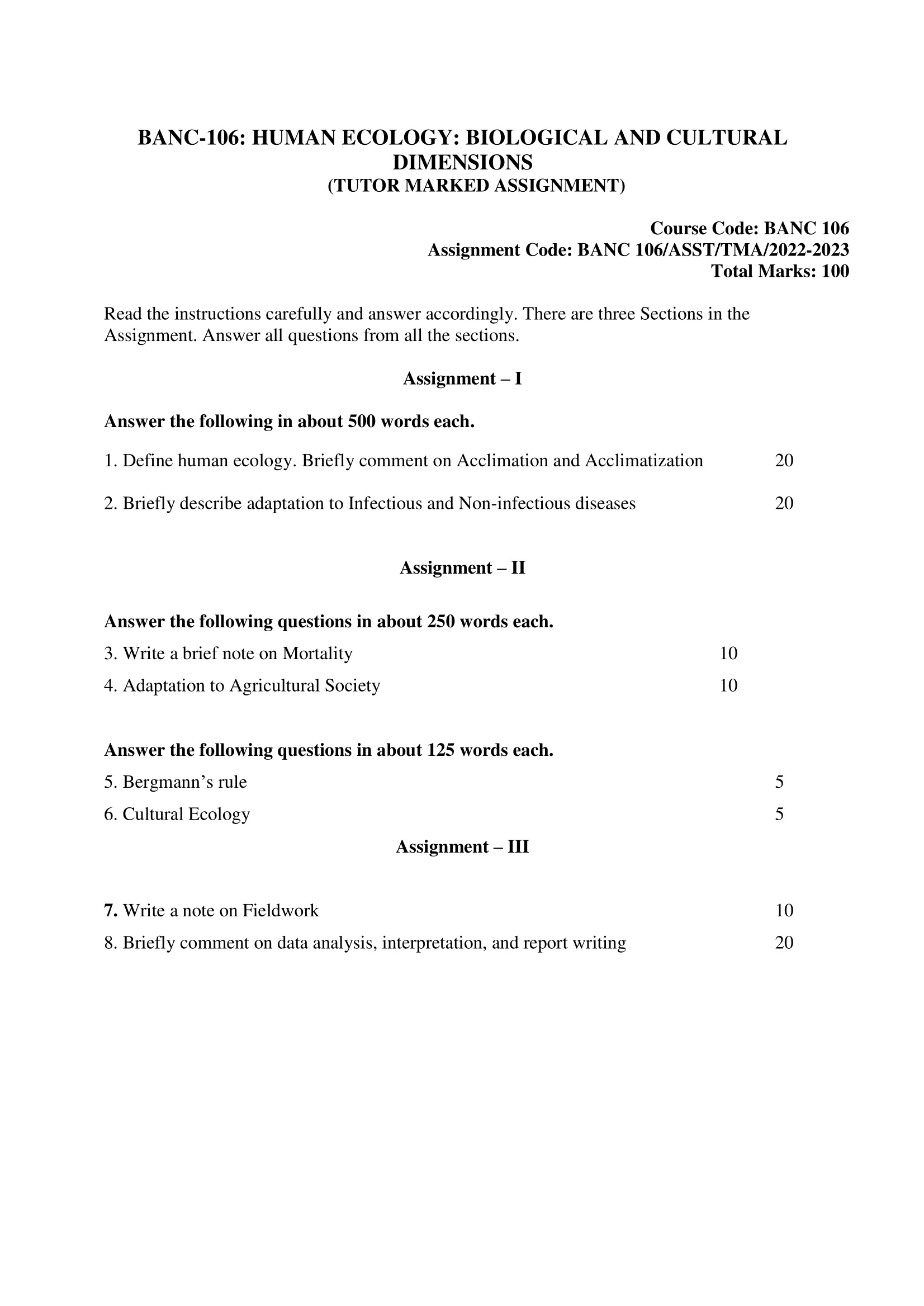
| Title | BANC-106: IGNOU BAG Solved Assignment 2022-2023 |
| University | IGNOU |
| Degree | Bachelor Degree Programme |
| Course Code | BANC-106 |
| Course Name | HUMAN ECOLOGY: BIOLOGICAL AND CULTURAL DIMENSIONS |
| Programme Name | Bachelor of Arts (General) |
| Programme Code | BAG |
| Total Marks | 100 |
| Year | 2022-2023 |
| Language | English |
| Assignment Code | BANC 106/ASST/TMA/2022-2023 |
| Last Date for Submission of Assignment: | For June Examination: 31st April For December Examination: 30th September |

Assignment – I
Answer the following in about 500 words each.
1. Define human ecology. Briefly comment on Acclimation and Acclimatization.
Ans: Human ecology is a branch of sociology that studies the relationships between humans and their natural, social, and built environments. It focuses on understanding how different environmental factors such as physical and social conditions, resources, and cultural beliefs, impact human health, development, and behavior. Human ecology views individuals, communities, and societies as interconnected and interdependent components of larger ecological systems.
Acclimation refers to the physiological changes that occur in an organism over a short period in response to a change in its environment. These changes are reversible and temporary and help the organism adapt to its new surroundings. For example, when a person moves from a cold to a warm climate, their body may experience acclimation by producing more sweat to regulate their temperature.
Acclimatization refers to the process of adjustment to a new environment over a longer period, which leads to permanent physiological changes. It is a slower process than acclimation and is generally seen as a response to a longer-term change in the environment. For example, when a person moves from a low to a high-altitude location, their body may undergo acclimatization by producing more red blood cells to help them adapt to the reduced oxygen levels at high altitudes.
2. Briefly describe adaptation to Infectious and Non-infectious diseases.
Ans: Adaptation to infectious diseases refers to the ways in which individuals, populations, and communities respond to and cope with the spread and impact of infectious diseases. This can include individual-level behaviors, such as practicing good hygiene, getting vaccinated, and seeking medical treatment when necessary, as well as larger-scale strategies, such as improving access to clean water and sanitation and strengthening public health systems.
Adaptation to non-infectious diseases refers to the ways in which individuals, populations, and communities respond to and cope with non-communicable diseases (NCDs), such as cardiovascular disease, diabetes, cancer, and chronic respiratory diseases. This can include individual-level behaviors, such as adopting healthy lifestyles (such as regular physical activity, healthy diet, and avoiding tobacco use), as well as larger-scale strategies, such as improving access to health care and promoting healthy environments (for example, through urban planning and design that encourages physical activity).
In both cases, adaptation efforts can be influenced by various factors, including access to information and resources, cultural and social norms, and local and national policies. Effective adaptation to infectious and non-infectious diseases requires a comprehensive and multisectoral approach, involving the active engagement of individuals, communities, and a range of public and private sector actors.
Assignment – II
Answer the following questions in about 250 words each.
3. Write a brief note on Mortality.
Ans: Mortality refers to the state or condition of being subject to death. It is the number of deaths in a given population over a specified time period, usually expressed as a rate per 1,000 or 100,000 individuals. Mortality is a critical indicator of the health and well-being of a population, and is used to track changes and trends in a population’s health over time.
Mortality rates can vary greatly depending on factors such as age, gender, geography, and the presence of disease or other health conditions. For example, in some countries, infant mortality rates (deaths of children under the age of 1) are higher due to poor access to healthcare, while in others, elderly mortality rates may be higher due to age-related health issues such as heart disease or cancer.
Mortality is also influenced by societal and cultural factors, including education, income, and access to healthcare. Societies with higher levels of education, wealth, and access to healthcare tend to have lower mortality rates, while those with lower levels of these resources tend to have higher rates.
The study of mortality is an important aspect of demography, public health, and epidemiology, and helps to inform public health policy and practice. Understanding patterns of mortality can help policymakers identify and address key health issues in a population, and inform the development of strategies for reducing the impact of disease and injury on the health of the population.
4. Adaptation to Agricultural Society.
Ans: Adaptation to Agricultural Society refers to the process of societal change that occurred as human populations transitioned from a hunter-gatherer lifestyle to one based on agriculture and the domestication of plants and animals. This transformation was a gradual and complex process that took place over thousands of years and varied in different parts of the world.
Agriculture allowed for the production of food surpluses, which in turn enabled the development of permanent settlements, increased population density, and the emergence of social and political hierarchies. With the advent of agriculture, people no longer had to rely solely on wild resources for their subsistence, but could instead cultivate crops and raise domesticated animals.
The shift to an agricultural way of life brought with it new challenges and opportunities. For example, while agriculture provided a more reliable source of food, it also made people more vulnerable to famine in times of crop failure. In addition, the labor-intensive nature of agriculture and the need to store food surpluses led to the development of social stratification, with some members of society specializing in food production while others pursued other occupations such as crafting, trading, and governance.
The transition to an agricultural society also had profound impacts on the natural environment. The clearing of forests and other habitats for crops and pasture land led to the loss of biodiversity, while the intensification of agriculture and the creation of irrigation systems altered local hydrological cycles and contributed to soil degradation.
Answer the following questions in about 125 words each.
5. Bergmann’s rule
Ans: Bergmann’s rule is a biological principle that states that within a species, individuals living in colder climates tend to have a larger body size than those living in warmer climates. This is because a larger body size is associated with a lower surface area-to-volume ratio, which allows for greater heat retention and energy conservation in colder climates.
The rule is named after the German biologist Carl Bergmann, who first proposed it in the mid-19th century. While it was originally formulated in the context of mammals, it has since been observed in a variety of other taxa, including birds, reptiles, and fish.
Despite its widespread acceptance, there are also many exceptions to Bergmann’s rule, and it is not always a reliable predictor of body size variation within a species. In some cases, other factors, such as differences in diet, behavior, and reproductive strategies, may also play a role in determining body size. Nonetheless, Bergmann’s rule remains a valuable tool for understanding patterns of adaptation and evolution in response to climate.
6. Cultural Ecology
Ans: Cultural ecology is an interdisciplinary field that explores the relationships between culture and the environment. It seeks to understand how human cultures interact with and influence their natural surroundings, as well as the ways in which the environment shapes cultural practices and beliefs. Cultural ecologists study the impact of human activities on the environment, and consider the social, political, and economic factors that influence environmental decision-making. They also examine the traditional ecological knowledge of indigenous peoples and how it has adapted to changing conditions over time. By examining the interplay between culture and nature, cultural ecology helps us understand the complex dynamics of human-environment interactions and the role of culture in shaping sustainable futures.
Assignment – III
7. Write a note on Fieldwork.
Ans: Fieldwork is an important component of many social science research methods, as it allows researchers to collect data in real-world settings. Fieldwork can involve a variety of activities, including observation, interviews, surveys, and participant observation. In fieldwork, the researcher typically becomes an active participant in the community or environment being studied, gathering data through direct interaction with people, objects, or other elements of the setting. The goal of fieldwork is to collect accurate and reliable data, and to gain a deeper understanding of the social phenomena being studied. Fieldwork can be challenging, as the researcher must be prepared to adapt to new and unpredictable circumstances, and to navigate ethical considerations such as informed consent and confidentiality. Despite these challenges, fieldwork is widely recognized as an effective way to gain rich and nuanced insights into social and cultural phenomena.
8. Briefly comment on data analysis, interpretation, and report writing.
Ans: Data analysis, interpretation, and report writing are crucial steps in the research process that allow researchers to make sense of the data they have collected. Data analysis involves organizing, summarizing, and transforming the data in meaningful ways so that patterns and relationships can be identified. Interpretation involves making inferences about the data, drawing conclusions, and explaining the meaning of the findings. In report writing, the researcher synthesizes the results of the analysis and interpretation, and presents the findings in a clear and concise manner, using tables, charts, and figures to illustrate the data. Report writing is an important opportunity for the researcher to communicate the results of their study to a wider audience, including academic peers, funding agencies, and the general public. Effective report writing requires clear and concise writing, attention to detail, and the ability to present complex information in a simple and accessible manner.
How to Download BANC-106 Solved Assignment?
You can download it from the www.edukar.in, they have a big database for all the IGNOU solved assignments.
Is the BANC-106 Solved Assignment Free?
Yes this is absolutely free to download the solved assignment from www.edukar.in
What is the last submission date for BANC-106 Solved Assignment?
For June Examination: 31st April, For December Examination: 30th October
